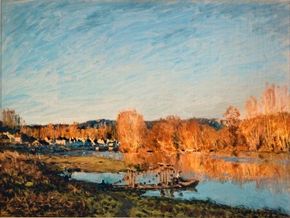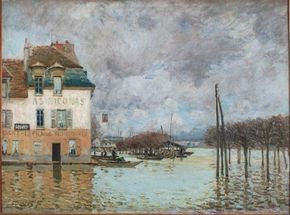Though Alfred Sisley never found the fame that some of his fellow Impressionists did, he was instrumental in the rise of the famous movement. Part of the famous Charles Gleyre studio -- along with Frédéric Bazille, Pierre-Auguste Renoir and Claude Monet -- Alfred Sisley learned the plein air techniques of the Barbizon School painters which he would employ throughout his career.
Alfred Sisley exhibited with the Impressionists throughout much of the movement, demonstrating commanding brushwork in his varied landscapes. However, a disagreement with Hilaire-Germain-Edgar Degas prompted Sisley, along with Claude Monet and others, to withdraw their works from the eighth and final exhibition. Despite this absence, Alfred Sisley's name will forever be connected to the Impressionists.
Advertisement
Below you will find links to some of Alfred Sisley's more well-known paintings. Click them to learn more about Alfred Sisley.
- Autumn: Banks of the Seine near Bougival: Autumn: Banks of the Seine near Bougival established Alfred Sisley as a staunch plein air painter. Learn about Autumn: Banks of the Seine near Bougival, which was shown at the Impressionists' first exhibition.
- Flood at Port-Marly: Flood at Port-Marly by Alfred Sisley may have been shown at the Impressionists' third exhibition, and demonstrates Sisley's command of landscape techniques. Read about Flood at Port-Marly by Alfred Sisley.
Alfred Sisley's dedication to the plein air movement is evident in the first Impressionist painting we will look at, on the next page.
For more on Impressionist paintings, artists, and art history, see:
For more on Impressionist paintings, artists, and art history, see:
Advertisement

